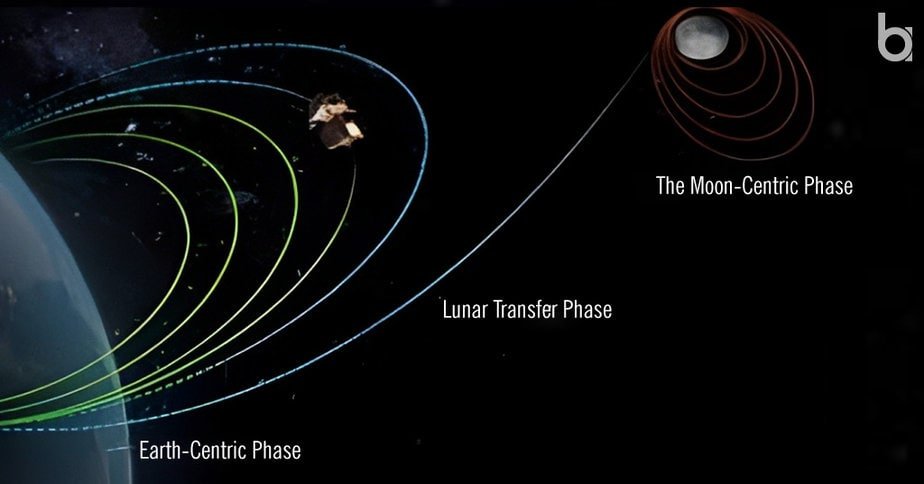Human curiosity shines as a guiding beacon in the enormous cosmic theater, as celestial bodies play over the infinite expanse of the cosmos, driving us to uncover the mysteries that lay beyond. Among these cosmic mysteries, our nearest cosmic neighbor, the moon, has long enthralled scientists and explorers. The Indian Space Research Organisation (ISRO), which guides India’s scientific and technical path, reached a watershed moment on August 22, 2023. They successfully launched India’s third lunar mission, Chandrayaan-3. The goal of this mission was to land a rover on the moon’s surface and uncover its secrets. Chandrayaan-3 not only achieved this aim successfully, but it also built on the accomplishments of its predecessors, Chandrayaan-1 and Chandrayaan-2, while also strengthening India’s global position in space exploration.
1. Phases of the Mission

The Chandrayaan-3 mission is a carefully choreographed ballet of three distinct phases, each a momentous stride in this celestial journey:
Earth-Centric Phase (Phase-1): This phase began on July 14, 2023, with the remarkable launch of the Chandrayaan-3 spacecraft. A Geosynchronous Satellite Launch Vehicle Mark III (GSLV Mk III) took off from the Satish Dhawan Space Centre in Sriharikota, India, with great aspirations and resolve. This amazing technology soared into the sky, bringing the spacecraft to life. Chandrayaan-3 then entered an orderly parking orbit around the Earth, where it awaited the next stages of its cosmic journey.
Lunar Transfer Phase (Phase-2): It began on July 22, 2023, transitioning smoothly. During this phase, Chandrayaan-3 took a calculated course across space towards the Moon. Over the course of five days, the spacecraft’s path intersected with the Moon’s gravitational pull, resulting in an encounter with our fascinating friend.
At the core of this mission stands the Pragyan rover, a lightweight entity weighing just 20 kilograms, teeming with immense potential. Bursting with scientific tools such as cameras, spectrometers, and magnetometers, this agent of knowledge set off on a transformative journey. Its aim is to methodically explore the lunar terrain, revealing the mysteries hidden by the Moon, including its geology, composition, and atmosphere. Pragyan, a name that signifies “wisdom” in Sanskrit, embodies the essence of exploration and enlightenment.
The Moon-Centric Phase (Phase-3): On August 5, 2023, a crucial point in Chandrayaan-3’s journey occurred. During this phase, the spacecraft gracefully entered lunar orbit, engaging in an enthralling interplay of technology and cosmic forces. In preparation for a soft landing, the spacecraft performed orbit-raising operations before falling gradually to the lunar surface. The landing was a success on August 23, 2023, and it marked the end of Chandrayaan-3’s careful rendezvous with the Moon’s regolith. The Pragyan rover will be released by the Vikram lander, signifying the transfer of human inventiveness onto the lunar canvas.
2. Scientific Pursuits
Chandrayaan-3’s scientific pursuits span multiple dimensions, promising a repository of insights that might reshape our perception of the lunar world:
1. Unveiling Lunar Terrain: Pragyan’s array of cameras and sensors enables an unprecedented analysis of the lunar terrain, documenting its properties with hitherto unseen precision. Collecting soil samples for analysis has the exciting potential of delivering critical signals regarding the existence of water ice and other vital materials.
2. Delving into the Lunar Atmosphere: The rover, outfitted with advanced instruments, is dedicated to studying the composition and structure of the moon’s delicate atmosphere. This mission’s goal is to identify the complexities of its atmospheric components, thereby enhancing our overall understanding of planetary atmospheres.
3. Geological Revelations: Pragyan embarks on an archaeological adventure to investigate the geological history of the moon, armed with spectrometers, magnetometers, and thermal mappers. This trip contributes to a better understanding of how the moon formed and how it has evolved over time by interpreting its composition and mineralogy.
4. Quest for Water Ice: The mission’s heart is at the lunar South Pole, where experts believe there is water ice, a resource that might bring about enormous changes. The rover’s examination into this potential game changer has consequences for prospective lunar and interplanetary missions, potentially changing the trajectory of space exploration.
3. Payloads

Lander:
Chandra’s Surface Thermophysical Experiment (ChaSTE): This instrument measures the thermal conductivity and temperature of the lunar surface in order to better understand its thermophysical dynamics.
Instrument for Lunar Seismic Activity (ILSA): A seismic monitor meant to study the lunar seismic environment surrounding the landing site.
Langmuir Probe (LP): This device calculates near-surface plasma density over time, providing insights into the moon’s electrodynamic properties.
Rover:
Alpha Particle X-Ray Spectrometer (APXS): APXS reveals the mineralogical elements of the lunar surface by calculating the chemical composition, creating a complete geological portrait.
Laser-Induced Breakdown Spectroscope (LIBS): LIBS determines the elemental composition (Mg, Al, Si, K, Ca, Ti, Fe) of lunar rocks and soil at the landing site, adding to our understanding of lunar geology.
4. Propulsion Module
Spectro-polarimetry of HAbitable Planet Earth (SHAPE): This component conducts spectral and polarimetric studies of Earth from lunar orbit in the near-infrared wavelength range (1–1.7 μm).
India’s lunar exploration project, Chandrayaan-3, equips a comprehensive set of scientific instruments with the goal of unraveling the mysteries of the Moon. The landing site measures 4 km x 2.4 km and rests at coordinates 69.367621 S, 32.348126 E.
This mission consists of two main modules: the Propulsion Module, responsible for guiding the Lander into lunar orbit, and the Lander Module, which houses the Rover. The total weight of the mission is 3900 kg.
Power generation occurs through solar panels. The Propulsion Module generates 758 W, the Lander Module generates 738 W with adjustments, and the Rover uses 50 W.
Communication occurs through the Indian Deep Space Network (IDSN). The Propulsion Module communicates with IDSN, the Lander Module communicates with both IDSN and the Rover, and a backup connection is planned with the Chandrayaan-2 Orbiter.
The Lander Module contains a wide range of sensors, including a Laser Inertial Referencing and Accelerometer Package (LIRAP), a Ka-Band Altimeter (KaRA), a Lander Position Detection Camera (LPDC), and other instruments. It also has four reaction wheels and a bi-propellant propulsion system with adjustable engines for mobility.
The specifications for the Lander’s touchdown are strict, allowing for a vertical velocity of ≤ 2 m / sec, horizontal velocity of ≤ 0.5 m / sec, and slope of ≤ 12 degrees. The scientific instruments on the Lander Module and Rover serve diverse and focused purposes.
The Radio Anatomy of Moon Bound Hypersensitive Ionosphere and Atmosphere (RAMBHA) payload aims to measure plasma density and its variations near the lunar surface. The Chandra’s Surface Thermo Physical Experiment (ChaSTE) aims to analyze the thermal properties of the lunar surface near the polar region.
The Instrument for Lunar Seismic Activity (ILSA) aims to detect seismic activity and characterize the lunar crust and mantle. The LASER Retroreflector Array (LRA) serves as a passive experiment to understand the dynamics of the lunar system. The Rover’s payloads include the LASER-Induced Breakdown Spectroscope (LIBS) for elemental analysis and the Alpha Particle X-ray Spectrometer (APXS) to determine the elemental composition of lunar soil and rocks.
The Propulsion Module payload, Spectro-polarimetry of HAbitable Planet Earth (SHAPE), aims to discover habitable exoplanets in the future by analyzing the reflected light. The Chandrayaan-3 mission aspires to illuminate lunar mysteries and enhance our understanding of the Moon’s composition and history.
5. Impact and Inspiration
Beyond its scientific underpinnings, Chandrayaan-3’s impact ripples across diverse dimensions:
1. Elevating Lunar Cognition: Chandrayaan-3 places India as a significant contender in solving lunar mysteries. The comprehensive experiments lead to a better understanding of the moon’s composition, assets, and history, which is in line with ISRO’s mandate for exploration and scientific inquiry.
2. Technological Enrichment: Chandrayaan-3 promotes local technology advancement as it brings in the age of gentle lunar landings. These breakthroughs go beyond the scope of the mission, enhancing India’s potential for more daring exploits in the cosmic arena.
3. Global Collaborative Impetus: The sharing of Chandrayaan-3 results and data fosters worldwide collaboration, increasing the global scientific community’s total knowledge of the moon. This spirit of collaborative exploration fuels scientific progress in a world interconnected by discoveries.
4. Igniting Youthful Aspiration: Chandrayaan-3 serves as a guiding light for young people in India and around the world. This massive project sends a clear message: the areas of research and adventure are within reach, bursting with potential waiting to be taken.
Chandrayaan-3 represents India’s supremacy in the cosmic domain. The rover’s launch, landing, and subsequent dispatch demonstrate India’s tireless dedication to advancing scientific and technological achievements. This mission expands our understanding of the moon and cements India’s place as a spacefaring nation. Beyond geographical and linguistic boundaries, Chandrayaan-3 speaks to the endless human desire for understanding and adventure, joining mankind in the common quest to find answers to the universe’s mysteries. The legacy of Chandrayaan-3 is set to inspire future generations, impact scientific conversations, and guide humanity into unexplored regions of discovery as it unfolds.
ALSO READ: Top Achievements Of ISRO: Revealing India’s Space Exploration Triumphs



